Let me walk you through it.

As you can see from the graph above, 2024 has been HOTTER than 2023 so far. This MASSIVE warming of the Global Ocean has become so alarming. That the field of Climate Science is in a crisis over it.
Earth Was Due for Another Year of Record Warmth. But This Warm?
-NYT 12/26/2023
Scientists are already busy trying to understand whether 2023’s off-the-charts heat is a sign that global warming is accelerating.
2023 was the warmest year in the past 174 years, and very likely the past 125,000.
“Unyielding heat waves broiled Phoenix and Argentina. Wildfires raged across Canada. Flooding in Libya killed thousands. Wintertime ice cover in the dark seas around Antarctica was at unprecedented lows.”
“That is why scientists are already sifting through evidence — from oceans, volcanic eruptions, even pollution from cargo ships — to see whether this year might reveal something new about the climate and what we are doing to it.”
“On its own, one exceptional year would not be enough to suggest something was faulty with the computer models, said Andrew Dessler, an atmospheric scientist at Texas A&M University.”
“Your default position has to be, ‘The models are right,’” Dr. Dessler said. “I’m not willing to say that we’ve ‘broken the climate’ or there’s anything weird going on until more evidence comes in.”
“In a much-discussed report last month, the climate researcher James E. Hansen argued that scientists had vastly underestimated how much more the planet would warm in the coming decades if nations cleaned up aerosols without cutting carbon emissions.”
Not all scientists are persuaded.
Ocean Temperatures Keep Shattering Records—and Stunning Scientists
-Wired 02/15/2024
Sea surface temperatures have been skyrocketing beyond expectations. That may be a bad sign for hurricane season—and the health of ocean ecosystems.
“A contributing factor to ocean warming might be the 2020 regulations that drastically reduced the amount of sulfur allowed in shipping fuels.”
Robert Rohde, lead scientist at Berkeley Earth, a nonprofit that gathers climate data.
“Basically overnight, it cut this aerosol pollution by about 75, 80 percent. That was a good thing for human health—the air pollution was toxic.”
“But sulfur aerosols attract water vapor, meaning that previously those ships would produce clouds in their wake—known as ship tracks—which, similar to Saharan dust, would bounce some of the sun’s energy back into space.”
-Rohde
“Now that we’ve cut it back, it has the side effect that some of that air pollution—that marine smog, if you might—is no longer there. The sky is clearer, so a little bit more sunlight is coming through.”
“Thus shipping regulations may have contributed A LITTLE BIT of ocean warming in heavily trafficked areas like the North Atlantic.”
Scientists Are Freaking Out About Ocean Temperatures
-NYT 02/27/2024
University of Miami, Brian McNoldy, an expert in hurricane formation.
“The North Atlantic has been record-breakingly warm for almost a year now. It’s just astonishing. Like, it doesn’t seem real.”
University of New South Wales, Matthew England, a professor at the who studies ocean currents.
“The sea ice around the Antarctic is just not growing. The temperature’s just going off the charts. It’s like an omen of the future.”
Cambridge, England, Rob Larter, a marine scientist who tracks polar ice levels.
“It’s quite scary, partly because I’m not hearing any scientists that have a convincing explanation of why it is we’ve got such a departure. We’re used to having a fairly good handle on things. But the impression at the moment is that things have gone further and faster than we expected. That’s an uncomfortable place as a scientist to be.”
“We all know that there’s been a rapid warming, particularly over the last few decades. But over the last 18 months, it’s jumped up way beyond what we expected.”

Scientists are offering a range of explanations for the record heat in the North Atlantic.
Seriously, this was what the NYT was printing as of Feb. 27th.
SOx Reduction:
“One factor may be a reduction in pollution in the area. In 2020, a new rule went into effect that limited the amount of sulfur dioxide contained in the fuel used by container ships. That has reduced the amount of particulate matter in the air, which let in more solar radiation and contributed to global warming.”
But the reduction of sulfur dioxide alone can’t explain the North Atlantic’s extreme heat, scientists say.
Reduced Cloudiness:
“Another factor may be the complex feedback loops in the Earth’s weather patterns. The North Atlantic has been unusually clear lately, with fewer clouds than normal to block the sunlight from heating the water.”
Slowing Atmospheric Circulation Patterns:
“The North Atlantic has been less windy than normal, which may have also led to a spike in temperatures. Less dust has been blowing off the Sahara Desert recently, for example. Normally this plume wafts over to the Americas, forming a giant umbrella that shades Atlantic water. As the winds have died, the umbrella has partially folded up, allowing more sunlight to beat down on the ocean.”
12 months of record ocean heat has scientists puzzled and concerned.
-NBC News 03/15/2024
The huge temperature anomaly — which climate change alone is unlikely to explain — could be a bad sign for hurricane season.
“Every day for the last 12 months, the world’s sea surface temperatures have broken records.”
“Ocean scientists are growing increasingly concerned.”
Brian McNoldy, a senior research associate at the University of Miami Rosenstiel School of Marine, Atmospheric, and Earth Science.
“It’s not just an entire year of record-breaking ocean temperatures, but it’s the margin it’s breaking them by — it’s not even close to what the previous record was. That’s what’s raising the eyebrows of a lot of people.”
“Human-caused climate change is likely playing a role, researchers said, but is probably not the only factor.”
Notice how mainstream media downplays “human-caused climate change” while still acknowledging it. This desire to be “balanced” actually DISTORTS the narrative.
“Climate models predict a steady rise in sea surface temperatures, but not this quickly. However, ocean surface temperatures also fluctuate and can be affected by natural climate variability, including patterns such as El Niño and La Niña.”
It could be this, it could be that, maybe El Nino, who knows?
“Scientists don’t yet know precisely why sea surface temperatures have climbed so high.”
John Abraham, professor at the University of St. Thomas, studies ocean temperatures.
“I pray we’re having a once-in-a-lifetime year of hot sea surface temperatures, but I do fear there may be something else going on that is causing a long-term change in sea surface temperatures we hadn’t predicted. All bets are off now, this is something that is so unusual, it’s challenging our past expectations.”
Why Is the Sea So Hot?
-The New Yorker 03/15/2024 by Elizabeth Kolbert, author of “Under a White Sky”.
“A startling rise in sea-surface temperatures suggests that we may not understand how fast the climate is changing.”
“Since the start of 2024, sea-surface temperatures have continued to climb; in February, they set yet another record. In a warming world, ocean temperatures are expected to rise and keep on rising. But, for the last twelve months, the seas have been so feverish that scientists are starting to worry about not just the physical impacts of all that heat but the theoretical implications.”
“Can the past year be explained by what’s already known about climate change, or are there forces at work that haven’t been accounted for? And, if it’s the latter, does this mean that projections of warming, already decidedly grim, are underestimating the dangers?”
Gavin Schmidt, the director of NASA’s Goddard Institute for Space Studies.
“We don’t really know what’s going on. And we haven’t really known what’s going on since about March of last year. It’s disquieting. The other thing that this could all be is, we are starting to see shifts in how the system responds.”
“All of these statistics that we’re talking about, they’re taken from the prior data. But nothing in the prior data looked like 2023. Does that mean that the prior data are no longer predictive because the system has changed? I can’t rule that out, and that would obviously be very concerning.”
-Gavin Schmidt, Director GISS
“The margin by which records are being shattered exceeds what’s usually seen during El Niños.”
Brian McNoldy,” hurricane researcher at the University of Miami.
“It’s not like we’re breaking records by a little bit now and then. It’s like the whole climate just fast-forwarded by fifty or a hundred years. That’s how strange this looks.”
“A variety of circumstances and events have been cited as possible contributors to the past year’s anomalous warmth.”
Here’s another set of “reasons” that are floating around.
Hunga Tonga Eruption in January 2022:
“In January, 2022, an underwater volcano in the South Pacific called Hunga Tonga–Hunga Ha‘apai explosively erupted. Usually, volcanoes emit sulfur dioxide, which produces a temporary cooling effect, and water vapor, which does the opposite. Hunga Tonga–Hunga Ha‘apai produced relatively little sulfur dioxide but a fantastic amount of water vapor, and its warming effects, it’s believed, are still being felt.”
Solar Maximum:
“The current solar cycle, known as Solar Cycle 25 is ramping up—it’s expected to peak this year or next—and this, too, may be producing an extra bit of warming.”
SOx Reduction:
“Regulations that went into effect in 2020 reduced the amount of sulfur in the fuel used by supertankers. This reduction, in turn, has led to a decline in a type of air pollution that, through direct and indirect effects, reflects sunlight back to space. It’s thought that this change has led to an increase in the amount of energy being absorbed by the seas, though quantifying the effect is difficult.”
Natural Variability:
“There’s also a lot of noise in the climate system. “This could end up just being natural variability,” Susan Wijffels, a senior scientist at the Woods Hole Oceanographic Institution, said.”
“I think the real test will be what happens in the next twelve months. If temperatures remain very high, then I would say more people in the community will be really alarmed and say ‘O.K., this is outside of what we can explain.’ ”
-Susan Wijffels Woods Hole Oceanographic Institute
In 2023, which was by far the warmest year on record on land, as well as in the oceans, many countries experienced record-breaking heat waves or record-breaking wildfires or record-breaking rainstorms or some combination of these.
Last year, in the United States, there were twenty-eight weather-related disasters that caused more than a billion dollars’ worth of damage, EACH, another record.
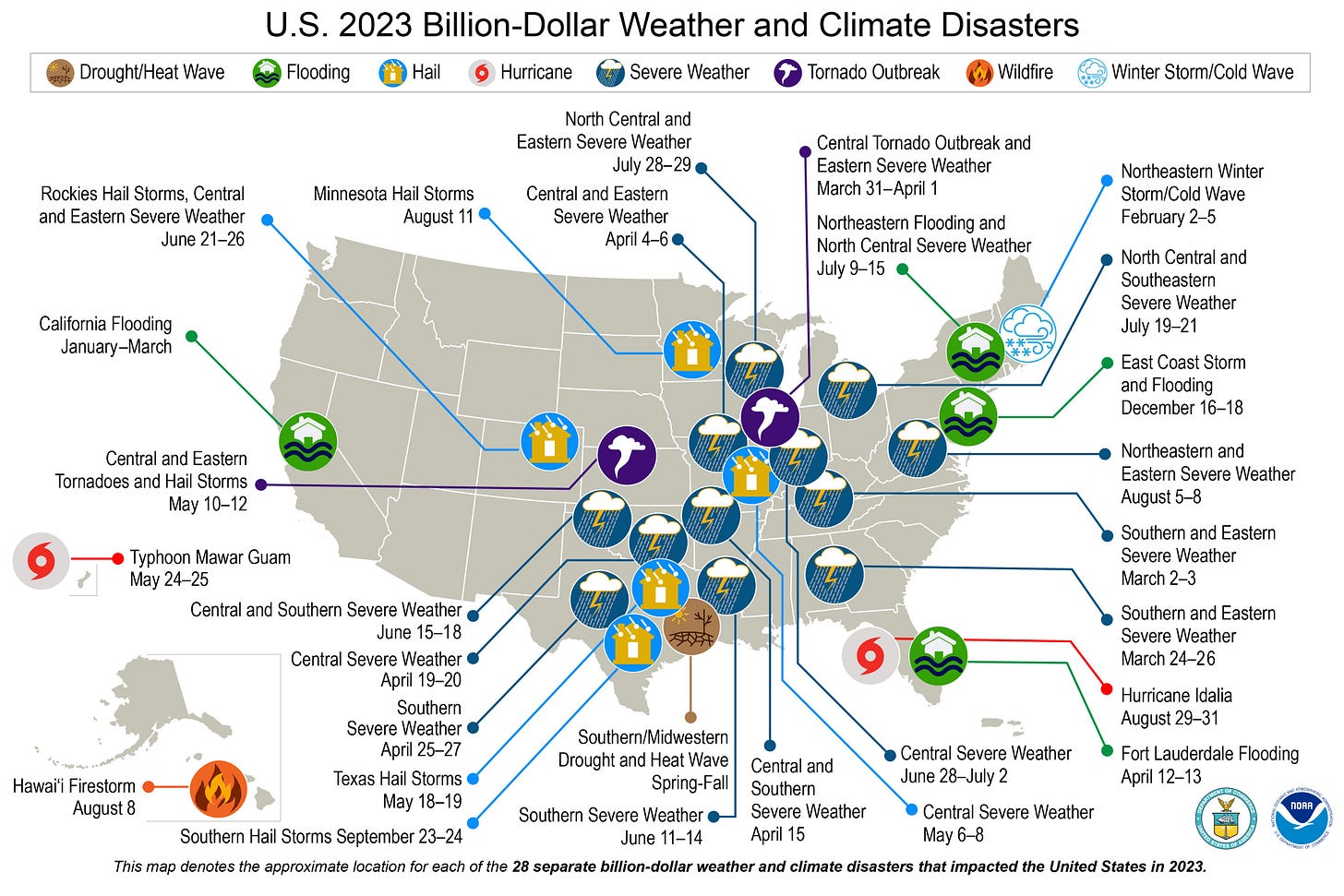
“If the climate projections are accurate, then the year was a preview of things to come, which is scary enough. But, if the projections are missing something, that’s potentially even more terrifying.”
-Elizabeth Kolbert author “The Sixth Extinction”
Do you FEEL informed now?
That’s what the “mainstream” is saying about this “unprecedented warming” of the oceans. They are basically telling us all to “wait and see”.

They are “hoping” that this El Nino acts like the last 2 and temperatures drop below what they were last year. As NASA\GISS endlessly repeated last year “2023 was the first time in 7 years that temperatures were higher than in 2016”. Mainstream Climate Science is HOPING that’s what will happen now.
Does that “satisfy” you in ANY way?
Allow me to present an alternative understanding of what this graph tells us.

After reading all of those articles, and dozens of others, it's clear that EVERYONE understands this is BAD. But, NO ONE seems to understand exactly what's going on here.
This isn’t that difficult to understand. Unless you don’t want to.
The REASON that the field of “Climate Science” is in CRISIS has very little to do with “climate science” and everything to do with “social science”. Specifically the social science laid out by Kuhn in his seminal work, ‘The Structure of Scientific Revolutions”.
Understanding this graph requires a PARADIGM SHIFT (a term coined by Kuhn) in our understanding of how the Climate System works.
Because, what you are seeing is the “collapse” of the paradigm of the Moderate faction in Climate Science. The faction that has dominated the field since the 80’s.
In order to fully understand this graph you will need some context and a bit of knowledge about how the Climate System works.
It STARTS with the SUN.

The ENERGY that powers the Climate System comes from the SUN.

A lot of the potential ENERGY from the Sun is reflected back into space. How much gets reflected is a property known as the Earth’s ALBEDO.
Core Concept: Albedo is a simple concept that plays complicated roles in climate and astronomy
The Earth has an “overall” ALBEDO value of about 0.31. Meaning about 31% of the ENERGY from the SUN is "reflected away" and does not go into the Climate System.
The ALBEDO is NOT a CONSTANT. It fluctuates over time. As it fluctuates the planet gets hotter or colder depending on if the Earth gets "dimmer" (lets in more ENERGY) or "brighter" (reflects more ENERGY).
The amount of ENERGY the Earth captures from the SUN is measured in terms of "Watts per sq. meter". The global average is about +193W/m2 each year.


The ENERGY from the SUN warms the land and oceans of the world. That accounts for 96% of what the Earth captures from the SUN annually. 3% of this ENERGY melts ice annually and 1% goes into heating the atmosphere directly. 91% of the ENERGY the Earth captures goes straight into the Global Ocean.
This captured ENERGY then radiates back into the atmosphere as HEAT.

Most of it "bleeds" away into space as part of how our planet sheds heat. SOME of it is "recaptured" and retained in the Climate System.
The amount of HEAT that's "recaptured" is a function of the amount of CO2 in the atmosphere. The higher the level of CO2, the more HEAT is retained in the Climate System.
The total amount of ENERGY going into the Climate System each year is known as the Earth Energy Imbalance or EEI.

The EEI is the SUM of the ENERGY going into the Climate System + the ENERGY being recaptured due to GHGs in the atmosphere - the amount of ENERGY that bleeds away.

It is CRITICAL to understand that the EEI has TWO INPUTS.
The ENERGY coming into the Climate System from the SUN.
The HEAT “recaptured” by the Climate System from the effect of GHGs.
If the EEI INCREASES there are only two possible reasons.
More ENERGY is being captured from the SUN. Either the SUN got brighter or the Earth got dimmer.
More HEAT is being recaptured in the Climate System because of a surge in GHG levels.
HEAT doesn’t “just happen”. It has to come from somewhere, and these are the ONLY possible reasons.
For the last 800,000 years the EEI has fluctuated between lows of -0.2W/m2 and highs of +0.2W/m2. The lows corresponding to global temperatures -6C below the 1850 baseline and the highs corresponding to our 1950-1980 temperatures.

Since 2004 the EEI has EXPLOSIVELY increased.
In 2004 the EEI was about +0.3W/m2.
In 2010 the EEI was about +0.5W/m2.
For 2023, Berkeley Earth calculated the EEI for the year was +1.85W/m2.
What does this MEAN in real world terms?
Ummm….
We have NO FUCKING CLUE.
Unprecedented ocean heating shows risks of a world 3°C warmer
January 31, 2024, University of Reading
Abstract:
“New research examines the causes of the record-breaking ocean temperatures witnessed in 2023. As of August 2023, the North Atlantic was about 1.4°C warmer than the 1982-2011 average.”
“Analysis of climate model projections showed that last year's extreme ocean conditions were similar to what scientists expect to be the average if global warming reaches 3°C of warming.”
“Currently, global temperatures have risen by only about 1.2°C above pre-industrial levels.”
The unspoken implication here is that we could be looking at a RAPID jump up to +3C of warming in order to reach thermal equilibrium again.
The study highlights that Earth's energy imbalance is likely a key driver of extreme ocean temperatures, as the planet is currently absorbing more than 1.9 watts per square meter more solar energy than it radiates back to space as heat.
What we DO KNOW is that.
The increase in the EEI corresponds perfectly with a sudden and MASSIVE drop in the planetary ALBEDO.

Since we started measuring the ALBEDO in 1999, the ALBEDO has been slowly declining as the planet warmed. Then in 2014 it started declining FAST.
Earth’s Albedo 1998–2017 as Measured From Earthshine
-pub. Aug 2021
The NASA CERES datasets show a decline in the ALBEDO of -1.8W/m2 by 2019.

That means, our planet got "dimmer" and started letting in more ENERGY from the SUN.
Currently, most of the HEAT in the Climate System isn't due to "recaptured" HEAT.
CO2 levels have been steadily increasing, but they didn't suddenly JUMP about 150ppm. The only way to increase the amount of "recaptured" HEAT in the system is to increase the amount of CO2 or CH4. There has been no sudden MASSIVE spike in the levels of either of these gases.
We are experiencing record temperatures globally because the Oceans are releasing some of the HEAT they have been soaking up.
What's heating up the oceans is the declining ALBEDO and the MASSIVE increase in the EEI that fuels.
James Hansen thinks that this is due to changes in maritime diesel fuels in 2020.
In 2020 the amount of sulfur in maritime diesel was reduced from 3.5% to 0.5%. This reduction was estimated to save millions of people a year from suffering premature deaths due to fine particulate pollution.
Since 2012, the EU has taken firm action to reduce the sulfur content of marine fuels through the Sulphur Directive. In 2016, the International Maritime Organization (IMO) maintained 2020 as entry-into-force date of the global 0.5% sulfur cap.
Shippers brace for new rules to cut deadly sulfur emissions (2016)
The shipping industry is among the world’s largest emitters of sulfur behind the energy industry, with the sulfur dioxide (SOx) content in heavy fuel oil up to 3,500 times higher than the latest European diesel standards for vehicles.
“One large vessel in one day can emit more sulfur dioxide than all the new cars that come onto the world’s roads in a year.”
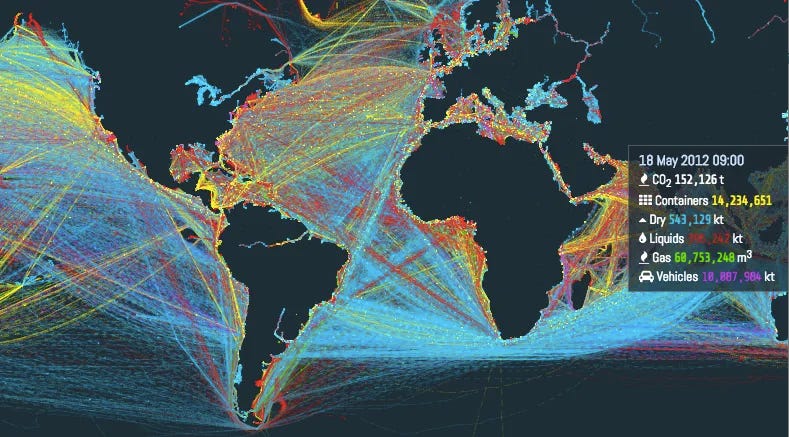
To combat such pollution, the International Maritime Organization’s (IMO) Marine Environment Protection Committee met in London on Oct. 24–28 (2016) and decided to impose a global cap on SOx emissions starting from 2020, which would see sulfur emissions fall from the current maximum of 3.5 percent of fuel content to 0.5 percent.
They EXPECTED that a reduction in those particulates would cause some Global Warming.
Before they did this, the International Maritime Organization did a study on the effect this might have on the Climate System. They knew that SOx particulates in the atmosphere have a "cooling effect" because they increase the planetary Albedo.
The IMO study, done in collaboration with the IPCC, used the STANDARD value of the Climate Moderates for the "cooling effect" of SOx particulates.
Historically, cargo ships have been powered by low-grade fossil fuels, which emit particles and particle-precursor vapors that impact human health and climate. We used a global chemical-transport model with online aerosol microphysics (GEOS-Chem-TOMAS) to estimate the aerosol health and climate impacts of four emission-control policies:
(1) 85% reduction in sulfur oxide (SOx) emissions (Sulf)
(2) 85% reduction in SOx and black carbon (BC) emissions (Sulf-BC)
(3) 85% reduction in SOx, BC, and organic aerosol (OA) emissions (Sulf-BC-OA)
(4) 85% reduction in SOx, BC, OA, and nitrogen oxide (NOx) emissions (Sulf-BC-OA-NOx).
The SOx reductions reflect the 0.5% fuel-sulfur cap implemented by the International Maritime Organization (IMO) on 1 January 2020. The other reductions represent realistic estimates of future emission-control policies.
We estimate that these policies could reduce fine particulate matter (PM2.5)-attributable mortalities by 13.3 million (Sulf) to 38.6 million (Sulf-BC-OA-NOx) mortalities per year.
These changes represent 0.3% and 0.8%, respectively, of annual PM2.5-attributable mortalities from anthropogenic sources. Comparing simulations, we estimate that adding the NOx cap has the greatest health benefit.
In contrast to the health benefits, all scenarios lead to a simulated climate warming tendency.
The combined aerosol direct radiative effect and cloud-albedo indirect effects (AIE) are between 27 mW m−2 (Sulf) and 41 mW m−2 (Sulf-BC-OA-NOx). These changes are about 2.1% (Sulf) to 3.2% (Sulf-BC-OA-NOx) of the total anthropogenic aerosol radiative forcing. The emission control policies examined here yield larger relative changes in the aerosol radiative forcing (2.1%–3.2%) than in health effects (0.3%–0.8%), because most shipping emissions are distant from populated regions.
Valuation of the impacts suggests that these emissions reductions could produce much larger marginal health benefits ($129–$374 billion annually) than the marginal climate costs ($12–$17 billion annually).
They estimated the change in marine diesel fuels would alter the Albedo forcing by no more than about -0.027W/m2. That's how low a value the Moderates put on the effect of SOx particulates in the atmosphere.
The projection by the IMO using the "best models" was that the change in diesel fuels would result in less than +0.03C of warming.
That's WHY Hansen calls what's happening "The Great Experiment".
The Moderates and IPCC have had their bullshit guesses put to the test. Now we can see for REAL how much ENERGY the SOx in the atmosphere was reflecting away.

It sure looks like the Alarmists were right and our SOx particulates were masking about +0.8C to +1.2C of warming.

Now we find out HOW FAST the planet can warm up in response to this.
In 2023 the EEI was about +1.85W/m2 by Berkeley Earth’s calculation.
This ENERGY IMBALANCE resulted in +15Zj of HEAT being added to the Global Ocean in a single year.

That's 471,000,000 Hiros worth of ENERGY added to the Global Ocean in a SINGLE YEAR.
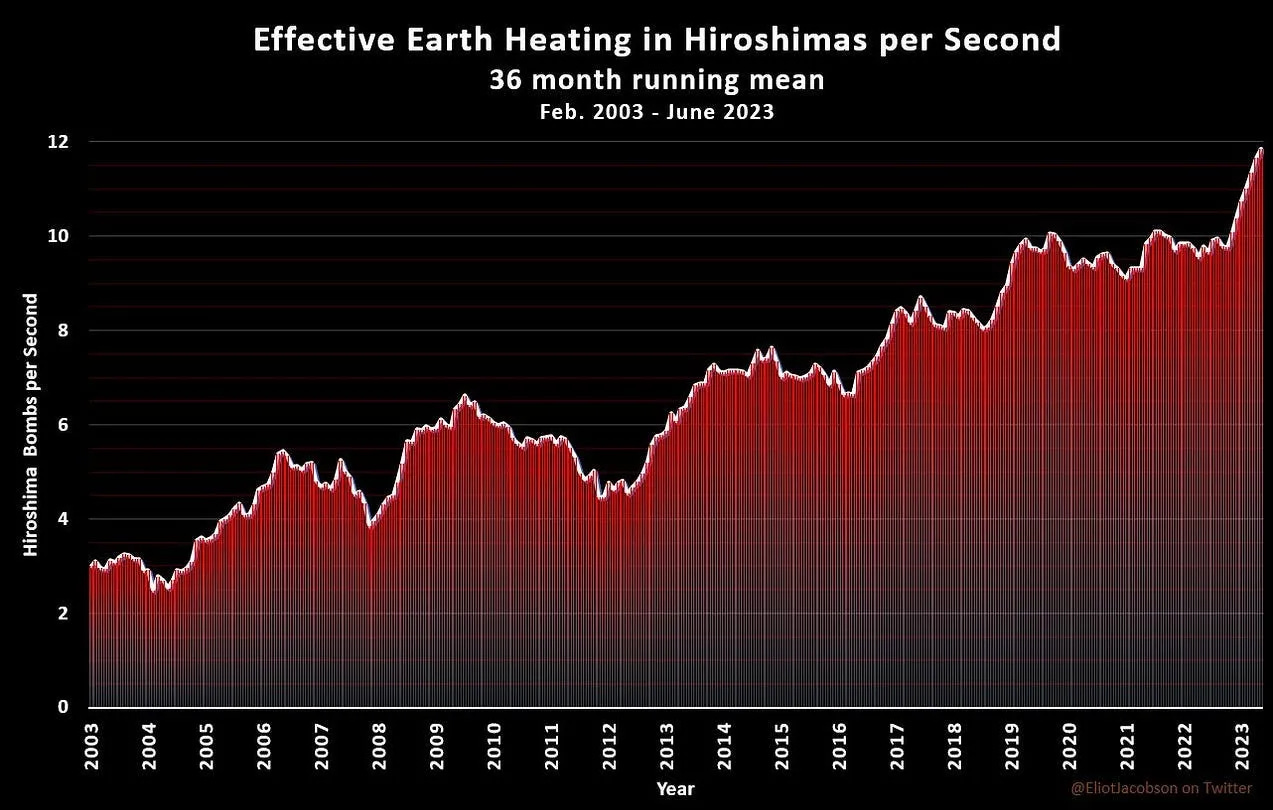
The Chicxulub Impact Event 65mya (the Dino Killer) released an estimated 10 Billion Hiros worth of ENERGY into the Climate System in a day.
Since the 1950's, we have added the equivalent of 14 Billion Hiros worth to the Global Oceans. Almost 500 million of that amount happened in 2023.
We will keep adding hundreds of millions of Hiros to the Climate System until the EEI begins to FALL. That's HOW this "imbalance" in the Climate System gets resolved. It’s the ONLY way this can resolve.
Global Temperatures, particularly of the oceans, will RAPIDLY climb until the EEI "imbalance" comes down.
We are watching “in real time” a MASSIVE SPIKE in Global Temperatures. A "thermal pulse" of warming that looks like a "blast wave" from a bomb is slowly sweeping across our planet right NOW.
WHAT THAT MEANS.
Using the values that are in the “standard models” of the Climate Moderates. Here’s the “official” understanding of what we are seeing.
The Earth Energy Inbalance is expressed in Watts per square meter (W/m2), which means the energy increase (or decrease) per square meter of the Earth. The Earth’s surface is expected to heat up by 0.8 °C (1.44 °F) for each 1 W/m2 increase.
-wikipedia
Using this value means that we are about to see a PERMANENT +0.8C jump in global temperatures over the 2008 temperature of +0.81C over the 1950-1980 baseline.
SO.
The most optimistic interpretation of this data is that we are about to JUMP up to global baseline temperatures of +1.6C to +1.7C over the next 2-3 years. A +0.5C to +0.6C JUMP from temperature levels in 2021/2022.
That’s actually what Hansen and the Chinese are saying.
If they are correct, as the oceans warm and global temperatures climb, the EEI will gradually fall. It will keep falling until the Climate System is roughly “in balance” again.
This will result in 2-4 years of HEATWAVES across the planet as the world adjusts to this MASSIVE surge of HEAT.
Heat Waves Are Moving Slower and Staying Longer, Study Finds
Climate change is making heat waves linger for longer stretches of time, exacerbating the effects of extreme temperatures.
Pretty much the way they did in the 30’s. The last time we had a sudden drop in global SOx levels as a result of social disruptions.
Then things should stabilize and go back to a steady increase in temperatures over time as CO2 levels rise.

MAYBE?
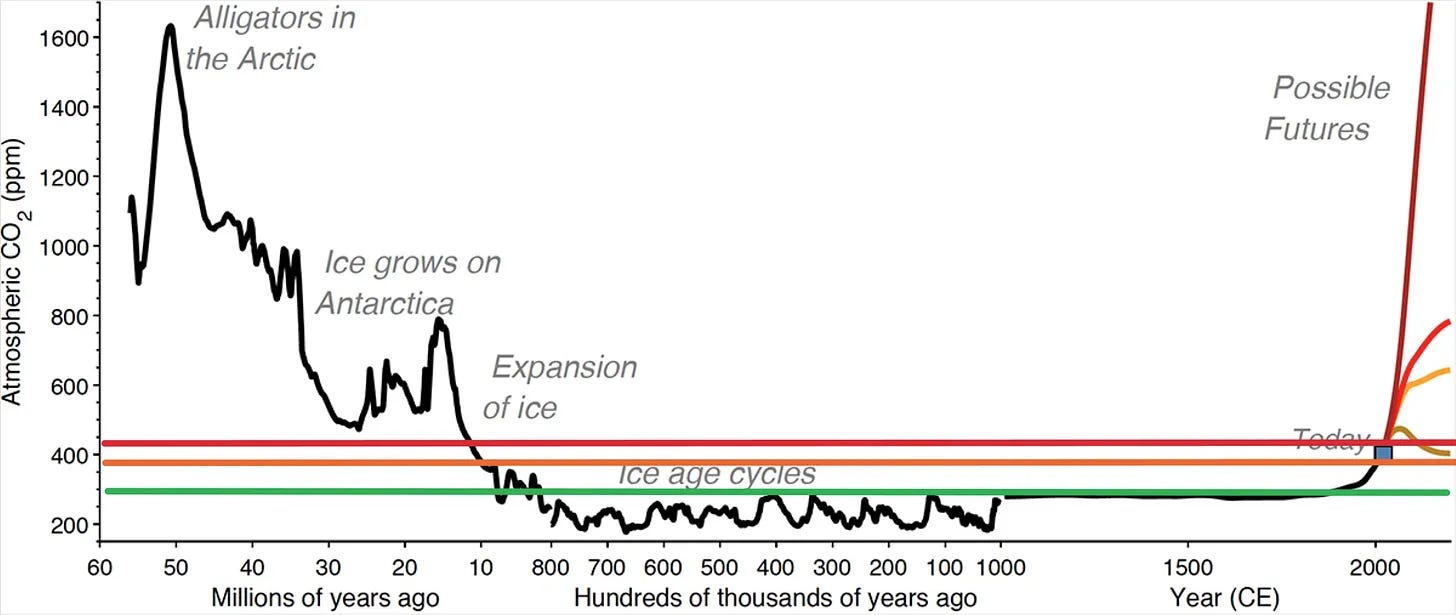
We really, DON’T KNOW what’s going to happen next. Remember these guys?
Unprecedented ocean heating shows risks of a world 3°C warmer
January 31, 2024, University of Reading.
If that +1.0W/m2 equals +0.8C of warming value is about 50% too low, like every other guess the Moderates made. Then we might not be looking at a JUMP to +1.7C but a BIG JUMP up to +2.5C over the next five years.
“Analysis of climate model projections showed that last year's extreme ocean conditions were similar to what scientists expect to be the average if global warming reaches 3°C of warming.”
The only other time something like this has happened was 56mya during a period known as the PETM.

Alligators lived around an ice-free Arctic Ocean.
Fifty-six million years ago, for instance, geologic turmoil added carbon dioxide to the atmosphere in quantities comparable to what humans are adding today. Temperatures jumped. The oceans grew acidic. Species died en masse.
The difference is that it took about 3,000 to 5,000 years to get there, compared to what we have done in just 200. When you set off a BOMB the results are unpredictable and chaotic.
The geologic record is not encouraging. It took about 150,000 years for the Earth to naturally process the “carbon pulse” of the PETM and temperatures started falling.
We have no idea what we have started. The Climate Moderates got EVERYTHING WRONG.
That's what this graph tells us, when you understand it in full context.
This is my analysis.
This is what I see.
This is my “Crisis Report”.
— rc 04022024
Personal Notes:
I appreciate all of my steady readers, I know that I have long dry spells when my output falls to nothing. I appreciate that you stay with me during these interludes.
Depression is a REAL Bitch.






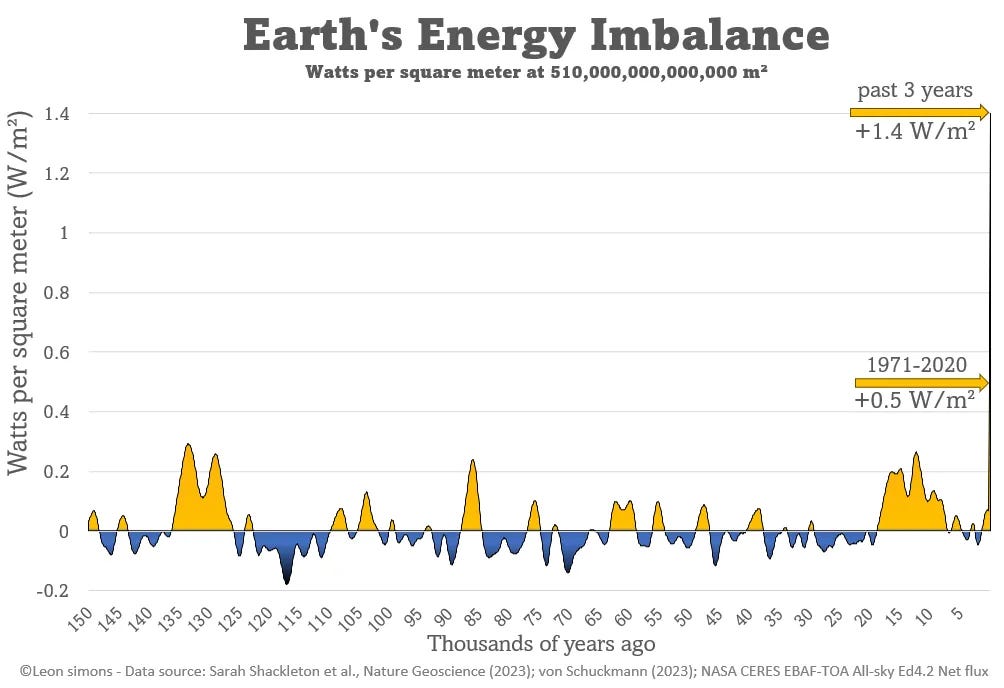

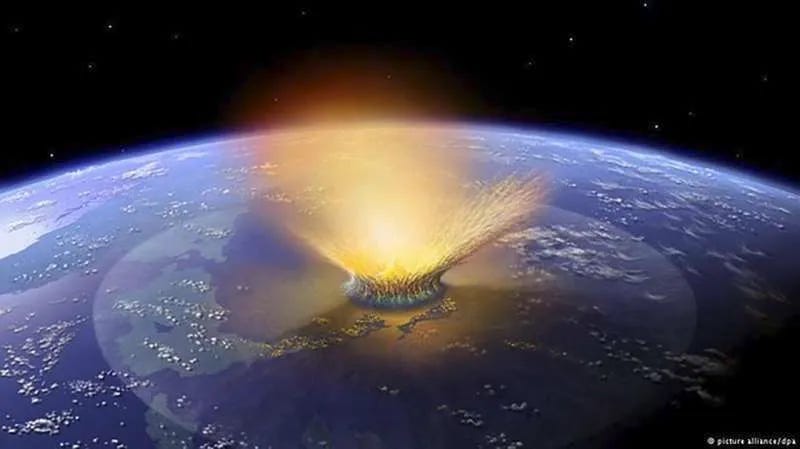
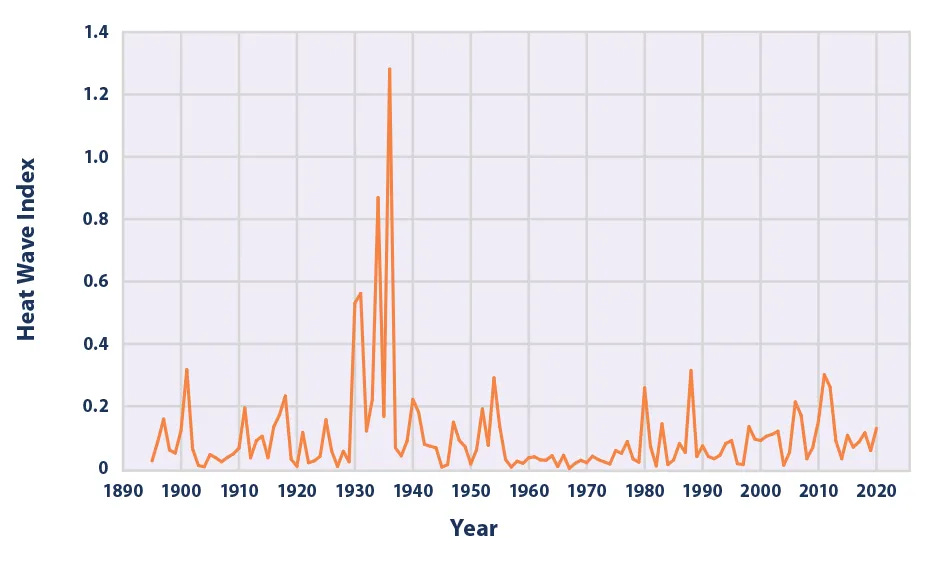
Actually, we do have a really good idea about what will happen.
The only real question is whether the total heat input we have already made or committed is sufficient to completely melt Greenland, or to break the oceanic clathrates. We can already see the Tundra destabilizing. If we are unable to stop that, well - game over. That's 1,500 gigatons of carbon into the atmosphere. And then there is no possibility that we keep Greenland from melting. The question then is HOW FAST. What appeared to be 300-500 years, now looks like 50-150.
So how do we know where we are?
Easy. Plot the CO2 equivalent over time. Hell, just take the current condition. Since the rest of the line is essentially a vertical line from the baseline.
Today we are about 550-560 ppm CO2(e). Methane is the major and dominant second source. Then add the rest of the warming gases.
Why? Because ALL of the warming gases count towards warming, not just CO2. CO2 vastly understates the hazard and lies about where we are - bad as it suggests.
At 550-560 ppm CO2(e) we are at twice baseline of 278 ppm CO2(e).
We debate about the "short" and "long" term climate sensitivity, And we continually underestimate those as Hanson and others have pointed out. And as the scientists at the COP are finally saying aloud - 30-40 years too late. That is 0.75 C per Watt/m^2.
But we never talk about the equilibrium climate sensitivity. And that is the most important. We know from the paleo climate record that the 105 k year ice age cycles take us from about 215 ppm CO2(e) at a low to about 280 ppm CO2(e) at the high. That then takes us from an arctic temperature of -8 C to + 6 C, so 14 C variation.
The implications are obvious.
But we can then also look back at the paleo climate to the last time we saw an atmospheric CO2(e) of 550-560. That takes us back to about 33 million years ago - long long long before man existed.
And that is about the time that antarctic glaciation was complete. By the time we reach 750 ppm CO2(e), we push that further back to 38 million years ago in the Eocene when the world had an "equable" climate.
No one understood how that could work. The ultra warm arctic breaks all of the models. Well - it does until you realize that it implies a different atmospheric structure that lacks Ferrell and Polar cells and has a single equator to pole Hadley cell, with giant cyclones running far north in a deeper atmosphere where Coriolis forces play a smaller role. I challenged the climate scientists about that in the 1990s, asking where we were thermodynamically. They went away and thought about it. They came back to say "we are close - very close".
Since then we have seen deepening of the Rossby waves and a slowing and destabilization of the polar jet. The huge heat intrusions to the north and cold to the south are artifacts of that destabilizing system and the breakdown of the main jet along with it.
Another climate scientist back in the 1950s modeled this. He and his grad students work stands alone. One of the things he predicted was third order effects causing what look like walls in the atmosphere. We saw the first of those with the Ridiculously Resilient Ridge. They are becoming common.
Where we are headed is to a rapid death of the oceans, and them going anoxic in large areas and vortexes - killing most life in the ocean, combined with the collapse of the tundra, and the breaking of the oceanic clathrates. Also the temporary shutdown of the AMOC and the Pacific circulation and with those the death temporarily of the great oceanic circulation.
In the immediate future, Europe north of Spain goes cold even as the Arctic heats. The oceans get unbelievably warm resulting in more massive storms. Cat 6 hurricanes become common with sustained winds of 185-218 (based on extension of the original scale).
The shift will be rapid, then sudden. And when it does we get perhaps a century to act as the Antarctic and Greenland provide a buffer. But most likely they are insufficient. We go to +11 C and an equable climate.
The transition happens so rapidly that 80+% of all species go extinct. Humans may be among those. Only some of our rare adaptations (like the high altitude genes) might spare a few.
That is where we are headed.
Thank you for this essay. I always appreciate you when you write.
And as one person to another who struggles with the same monster-I understand completely.